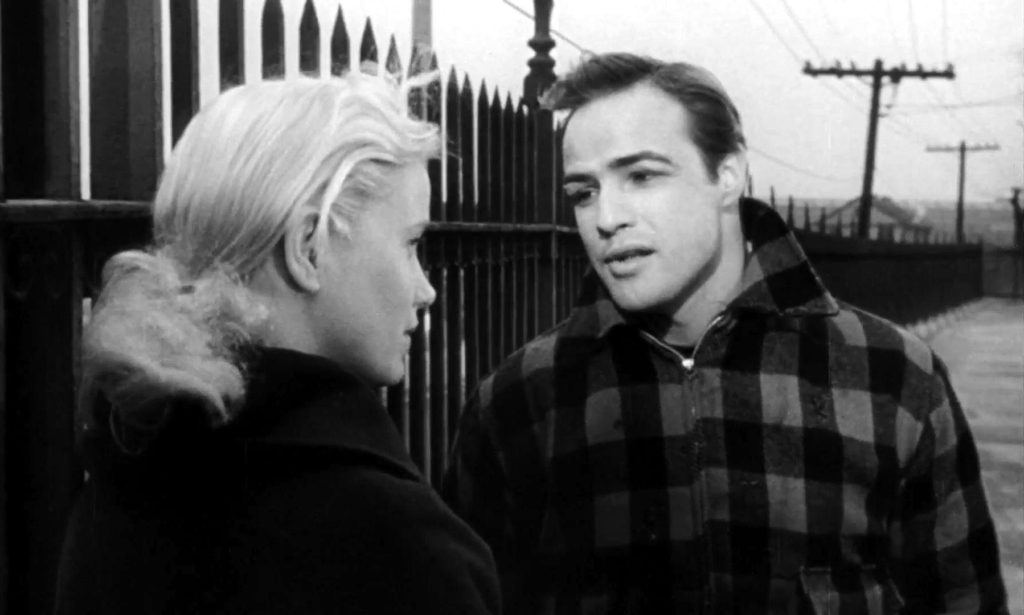
When we first see the priest, he is leaning over a grieving woman. He is reading the Bible to her and praying for her. He is doing his duty. Father Barry has just arrived after longshoreman Joey Doyle was pushed to his death from the top of a tall building. Edie is the woman who is in shreds on the ground as she grieves her brother Joey. When Edie rushes in tearful outrage to the body, the priest tries to calm her by saying, “Edie, time and faith, remember, time and faith are great healers, Edie.” Incredulously, Edie answers, “Father, my brother is dead and you talk about time and faith.” Now Father Barry’s retreat : “I’m in the church if you need me.” Then comes Edie’s reply as a slap to the face : “You’re in the church if I NEED you? Did you ever hear of a saint hiding in a church?”
One of the most charged elements of Elia Kazan’s superconductor melodrama is the way Father Barry learns not to hide. After that early moment when he is rebuked for hiding in his church, the priest makes several blistering moves toward faith that lives not only in the heart and the church but in the extended hand and voice.
First of all, he gathers the workers together in the church to urge them to speak the truth about Joey’s murder, saying “How can we call ourselves Christians and protect these murderers with our silence?” The church meeting culminates with a commitment from the priest to stand by Kayo Dugan, a worker who is poised to take a dive into truth-telling. This from the lips of Father Barry : “You stand up and I’ll stand up with you.”
Later in the film when Dugan himself is killed for standing up for the truth, the priest has a chance to “stand up” with him in one of the greatest of all film speeches. From the bottom of a ship cargo hold with the dead worker lying beside him, Father Barry speaks to a host of dock workers with the mobster union boss Johnny Friendly looking on. With a fearless but loving roar, the priest says, “What does Christ think of the easy money boys who do none of the work and take all of the gravy? And how does he feel about the fellas who wear a hundred-and-fifty dollar suits and diamond rings on your union dues and your kickback money? And how does he, who spoke up without fear against every evil, feel about your silence?” Content no longer to urge the oppressed to be healed only by time and faith, Father Barry comes roaring out of the “hiding” place of his church to be a loud voice for justice and truth.
The idea of hiding, and specifically hiding from the truth and conscience, haunts this whole film. Many characters have to decide whether they will tell the truth or hide from it, and whether they will hear the voice of their conscience or hide from it. Most centrally, there is Marlon Brando’s Terry Malloy, who sneers near the start of the film, “Conscience…that stuff can drive you nuts!” His own progression away from hiding is a great companion for the priest’s, and the way the two characters make this journey in parallel is a compelling part of the film.
Now, we know from director Elia Kazan’s life story that he himself was proud of not “hiding” when the House Committee on Un-American Activities (HCUA) came knocking in 1952. In his testimony before the HCUA, Kazan identified eight of his former fellow theater members as Communists. It appears that Kazan thought of this film, released two years after the testimony, as a dramatization and defense of his own actions before the Committee. Fortunately, the film is so powerful that it stands on its own apart from Kazan’s own life story, and to be honest I would not value this film nearly so much if I thought I had to read it narrowly through the lens of the director’s life.
So are we and Kazan done with time and faith as healers? Far from diminishing faith, in the end, the priest in his cargo hold speech also opens a window to a profound spiritual reality that saturates the rest of the film : “And if you don’t think Christ is down here on the waterfront you’ve got another guess coming. Every morning when the hiring boss blows his whistle Jesus stands alongside you in the shape-up. He sees why some of you get picked and some of you get passed over. He sees the family men worrying about getting the rent and getting food in the house for the wife and the kids. He sees you selling your souls to the mob for a day’s pay…But remember Christ is always with you. Christ is in the shape-up, he’s in the hatch, he’s in the union hall, he’s kneeling right here beside Dugan. And he’s saying to all of you: ‘if you do it to the least of mine you do it to me.’” At this point, On the Waterfront suggests thatthe truth-telling, the justice, and the stepping out from hiding are sanctified because they are done with an all-seeing, merciful, and speaking Christ who is there on the docks beside us. We stand on the docks with the Christ who, though unseen,is truly not hiding.
– Brian Duignan
- Directed by: Elia Kazan
- Produced by: Sam Spiegel
- Written by: Budd Schulberg Malcolm Johnson Robert Siodmak
- Music by: Leonard Bernstein
- Cinematography by: Boris Kaufman
- Editing by: Gene Milford
- Release Date: 1954
- Running Time: 108
- Language: English
Arts & Faith Lists:
2004 Top 100 — Unranked List
2020 Top 100 — #85